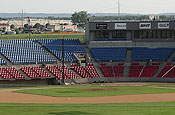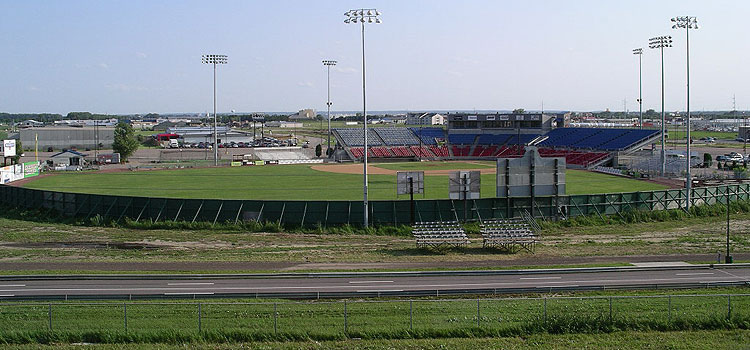
 Baseball Pilgrimages Baseball Pilgrimages
| Ballpark Attendance |
| Year | Total | Average |
2016
2015
2014
2013
2012
2011
2010
2009
2008
2007
2006
2005
2004
2003
2002
2001
2000
1999
1998
1997
1996
1995
1994
1993 |
68,278
77,429
50,746
52,052
55,627
64,000
56,428
70,978
87,616
92,786
88,408
113,590
120,681
91,005
109,355
112,115
105,888
118,333
120,114
134,580
147,062
149,770
140,224
112,971 |
1,366
1,647
1,057
1,062
1,135
1,306
1,227
1,479
1,947
1,974
1,922
2,366
2,514
2,068
2,327
2,607
2,521
2,752
2,930
3,204
3,587
3,483
3,506
3,053 |
| * Attendance figures listed are the regular season totals drawn by the Sioux City Explorers at Lewis & Clark Park |
| Travel Info |
Nearest Pro Ballparks:
Sioux Falls Stadium in Sioux Falls, SD (96.8 miles)
Werner Park in Papillion, NE (107.5 miles)
Haymarket Park in Lincoln, NE (148 miles)
Principal Park in Des Moines (194.5 miles)
|
| Ballpark Directory |

See all the ballparks, like Sioux City's Lewis & Clark Park, in which professional baseball is played. Our Pro Baseball Ballpark List includes every current one.
|
Baseball Pilgrimages
Where the pursuit of baseball never ends.
[Site Map]
|
|
 |
A textbook example of a basic ballpark/simple stadium stands in Sioux City, where the non-fancy facility began its life as one of a kind. While Lewis & Clark Park lacks a lot of modernism, it was the first brand new ballpark to be built for an independent league team in the modern era of indy ball, which began in 1993, and the Sioux City Explorers have been playing there ever since.
The Explorers' home has always been a simple structure, with its grandstand filled with red and blue seats that separate it into unequal halves. The red seats are beneath a cross aisle, the more voluminous blue seats are above it, and the coloring of the ballpark's plastic chairs can generally be considered as its signature feature.
An elevator tower protrudes above the grandstand's third base side. It's adjacent to the rectangular press box building that also contains luxury boxes. The grandstand itself lacks the luxury of a roof, so all of the dual-colored seats in it are uncovered and the stands themselves span no further than the edge of the infield, although the third base side extends an extra section's worth of seats further than the first, which not coincidentally makes it the home "half" of the stadium.
Aside each end of the concrete grandstand is a set of metal bleachers, with the bullpens found along the foul lines beyond them. All the way down the left field line is a picnic table-filled wooden party deck. And that's the end of the stadium's confines.
Beyond the outfield fence in left is a rudimentary scoreboard (of the classic linescore variety) and close to it is a small display board that can show player stats. Behind the grandstand is where concessions and bathrooms are found. That means the concourse has no view of the playing field, which overlooks a grassy hill, highway and trees.
Without a lot to explore or room to roam, Lewis & Clark Park is certainly a product of its times and intended for level. It was the original crown jewel of non-affiliated minor league baseball and spawned a successful lineage of independent ballparks but as the years pass by Sioux City's ballpark becomes more symbolic of the past than the symbol of a baseball renaissance it originally represented.
Now one of the smallest indy league ballparks -- none in the Explorers' 13-team league can hold less fans -- the unpretentious venue that returned pro baseball to Sioux City after a 33-year absence highlights just how far ballparks of its classification have come since Lewis & Clark Park secured its legacy by simply being built.
Location
Lewis & Clark Park is found roughly five miles south of downtown Sioux City, which is Iowa's fourth most populated city. The ballpark overlooks Highway 75, a multi-lane Interstate look-alike that is elevated by a hill so that the cars and semis traveling on it dominate the backdrop. Those driving west by the ballpark on what's actually a combination of US highways 20 and 75 will cross over the Missouri River, and thus into Nebraska, in less than a mile, as the river serves as the border between the two Midwestern states. Between the Missouri River and Lewis & Clark Park is I-29 and traveling north on the Interstate will take you right into the heart of Sioux City, which is the proverbial hop, skip, and a jump away from the South Dakota border. The home of the Explorers is just 10 miles from the Iowa-South Dakota line, which is the Big Sioux River.
Notable something-fun-to-do places within walking distance of Lewis & Clark Park are an indoor ice skating rink (IBP Ice Center) and an entertainment complex (Rush Werks) that includes a bowling alley. Both have addresses of Stadium Drive, which intersects with Line Drive in front of Lewis & Clark Park. There's a small industrial park along Line Drive, which is the quarter-mile long access road to the stadium from Hwy 75. A stretch of road about the same length that's almost directly behind left and center field is home to the Greater Siouxland Soap Box Derby and their sloped track is where kids have raced their creations since it was built in 2003.
Parking
There's plenty of spaces in which to park in front of the stadium, as a large paved lot extends to each foul pole (and a little beyond). There is a charge for parking but it's a small fee ($2 in 2015).

|
Lewis & Clark Park Facts, Figures & Firsts
Construction cost: $3.5 million
Financing: Revenue bonds were used after their issuance was approved in a 4-1 vote by the city council.
Built on land that had previously been a cornfield.
Owned by the City of Sioux City.
Named for the famed exploration duo of Meriwether Lewis and William Clark, who led the first American expedition to the western frontier, during which Charles Floyd became the sole member in the Lewis and Clark Expedition party to die in present-day Sioux City on August 20, 1804.
Has 4 suites. There are two on each side of the press box.
The Explorers' (home) dugout is on the third base side of the stadium.
Was host to the NAIA World Series from 1995-1997. The winners of the small college baseball championships played here were Bellevue (1995), Lewis-Clark State (1996) and Brewton-Parker (1997).
First game: June 22, 1993; the Sioux City Explorers hosted the Rochester Aces. Rochester's Kash Beauchamp hit the first home run in ballpark history.
Prior to its construction the last time pro baseball had been played in Sioux City was in 1960, when the Sioux City Soos played at Soos Park, which was converted into a racetrack (for cars) in 1964. The site of the old ballpark, which was built in about a month in 1947, was 5 miles north of Lewis & Clark Park. The address for Soos Park was 1420 Steuben Street.
|
|
